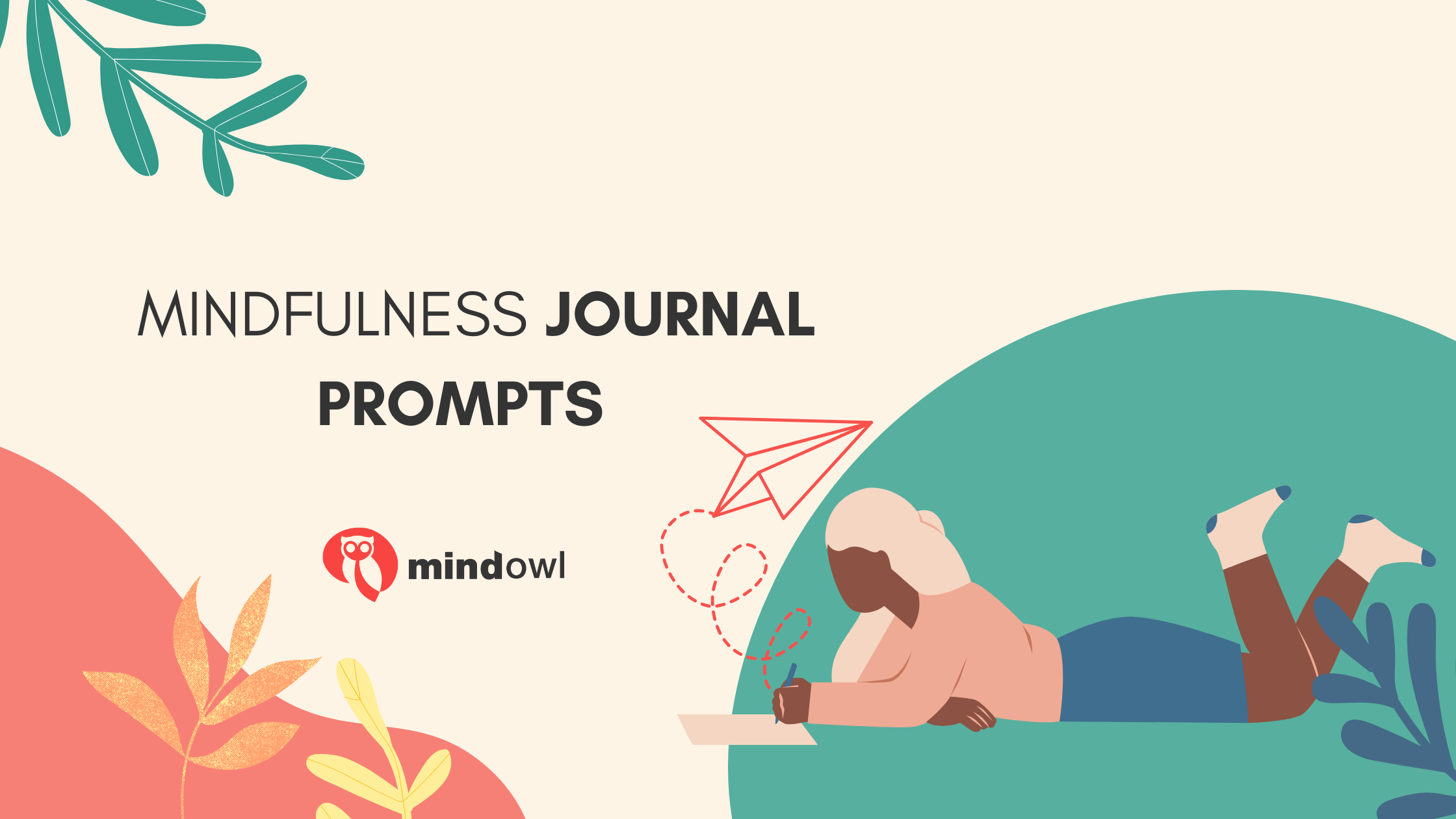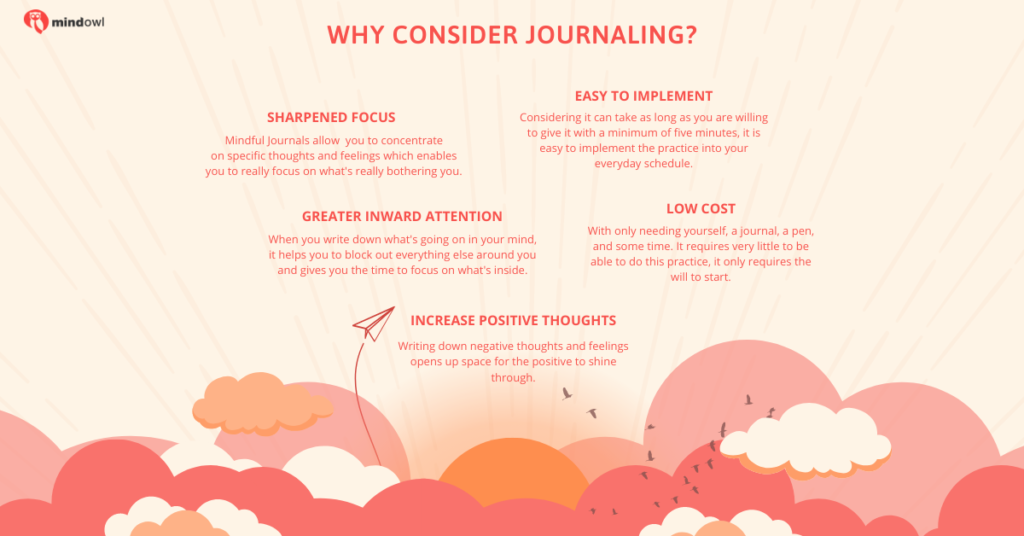Mindfulness is simpler than many people think, although it can still be difficult to implement at first. For that reason, it can be useful to start with something small, like the simple process of writing down your thoughts and feelings within a mindfulness journaling session.
Mindfulness journaling has become popular for good reason. It’s really easy to implement, it can be done just about anywhere, and it’s super low cost — it only requires your time and effort. In today’s article, we’ll guide you through how to incorporate this practice into your daily life. Mindfulness journaling is suitable for both beginners and more long-term practitioners of mindfulness, so if you’re ready, get out your journal, find a quiet place, and let’s begin!
What Is Meditative Journaling?
Meditative journaling can help people discover the benefits of mindfulness by encouraging them to note down their experiences of present-moment attention and contemplation. Reflecting on your thoughts and experiences provides insight into the process of learning mindfulness, and writing about those experiences is a great way to master the practice. Mindfulness journaling can provide a permanent record of your intentions in life and therefore help you live with more purpose and intentionality.
Mindfulness is being aware of what you’re doing right now, and journaling can be a great way for you to develop this skill. It takes time and effort, but journaling can help you remember what you’ve done well and consider what you need to improve upon, which is extremely valuable when it comes to pushing forward your meditation journey. You can also use it to reflect on how you’re feeling during meditation.
Why Consider Journaling?
Journaling is a simple way to get started with mindfulness. It helps you to become more aware of your thoughts and feelings, in order to separate yourself from the more negative ones and the impact they may have.
Here are a few reasons why you should consider journaling:
- Sharpened focus – Mindful Journals allow you to concentrate on specific thoughts and feelings which enables you to really focus on what’s bothering you.
- Greater inward attention – When you write down what’s in your mind, it helps you to block out everything else around you and gives you the time to focus on what’s inside.
- Increase positive thoughts – Writing down negative thoughts and feelings opens up space for the positive to shine through.
- Low cost – With only needing yourself, a journal, a pen, and some time. It requires very little to be able to do this practice, it only requires the will to start.
- Easy to implement – Considering it can take as long as you are willing to give it with a minimum of five minutes, it is easy to implement the practice into your everyday schedule.
Journaling and Mindfulness
Journaling can be an important tool within your mindfulness practice. There are various different types of journals you can keep, including a daily diary or a travel journal — it all depends on your individual journey and what you want to get out of this practice. Before we get into this in more detail, let’s quickly consider the tools you’ll need for mindfulness journaling.
- A pen
- A quiet place to reflect or consider
- 5-10 minutes of your time
- And of course a journal
Mindfulness is a useful tool for helping people overcome depression and anxiety and become more aware of themselves and others. Within mindfulness journaling, the practice of writing things down can help you process certain thoughts and emotions, and place them somewhere accessible, allowing you to have a full overview of your progress.

What Mindfulness Journals do
Mindfulness journals help you to reflect on and pay focused attention to your thoughts, feelings, emotions, and experiences. This can help you become more mindful of daily events and how you respond to them, which can help you manage everyday stresses and depressive symptoms.
Writing down what’s going through your head when you’re having an emotional reaction can be highly beneficial. For instance, if you want to lose weight, you might write down everything you eat and drink every day. Then, after a few weeks, you’ll see how much you’re eating. With this information, you can plan an exercise routine or dietary changes to help you to lose weight. That being said, mindfulness journaling shouldn’t become an overly self-critical process; for a truly healthy relationship with food, you should check out our article on mindful eating.
Journaling helps you process difficult experiences and accept them for what they are. It helps you to release destructive emotions in a controlled manner. It also makes you more aware of emotional triggers and better able to express your thoughts and feelings without fear of judgement. The creative process of journaling can lead to better cognitive processing, increased communication skills and better moods.
So how should someone interested in journaling get started? To answer that question, we’re going to take you through some useful prompts to get your creative juices flowing.
Examples and Prompts
One of the benefits of journaling is that it can help you analyse how you feel about something specific, and you can always come back to this feeling later if something similar occurs. This process can help you track your responses and reactions to things, and see whether they change over time. With this in mind, let’s look at some writing prompts that can help you bring the reflective power of mindfulness into your daily life.
Daily Outlines
Daily journaling can be helpful with offloading stress and relaxing. In the same way that a consistent meditation routine can be super useful, setting aside some time at the beginning and end of each day can be the perfect way to start journaling.
Here are some mindfulness journal prompts for the start of your day:
- What are some things I am looking forward to today?
- What challenges might I face today?
- What can I do if I feel stressed today?
Here are some prompts that can be used for the end of your day:
- What positive things happened today?
- Did anything go wrong today?
- Can I do something different tomorrow?
You could use these same prompts to create monthly journal outlines. For example, at first, you could choose an area of your life, and then specify three prompts that you can use that month to guide your journaling.
Monthly Theme Prompts
Let’s delve deeper into the subject of monthly prompts and outlines. Each month, assigning a theme to focus on in your journal can help you identify and track your key aims and hopes. During the middle of the month, you can consider how you feel things are going, and then at the month’s end you can talk about whether certain targets were achieved, and what you could do better next time.
Here are some examples of monthly themes:
- Physical health – January
- Expressing love and honesty – February
- Mindfulness at work – March
- Thinking before speaking – April
- Mindful eating exercises – May
- Checking in with loved ones – June
- Your Journey – July
- Checking up with yourself – August
- Mindful meditation practice– September
- Mindful holidays– October
- Mindful thinking – November
- Mindful gift-giving– December
Daily Prompts
We’ve provided a list of prompts that you can use to keep track of your thoughts and feelings throughout the day. These prompts include positive experiences. This is to guide you into more positive thinking in your everyday life.
- What was your happiest moment today?
- How did you overcome your scariest moment?
- Consider any urges that you resisted today.
- Was there something productive you did today?
- What are three things that you learned today?
Other Examples
Journaling is similar to keeping a diary in many ways, in that it allows you to write down your daily activities or record your feelings. There are no hard and fast guidelines for you to follow, and there are a few other examples of good prompts to help you get the best out of your mindfulness journaling. Let’s go through some more.
Example 1: Gratitude journaling
Mindfulness intervention programs such as Mindfulness-Based Stress Reduction often use journaling, with one of the most common techniques used is the gratitude journal format.
Gratitude journaling involves considering things we could be thankful and/or grateful for in our lives, both big and small. Think back over the last week, moment by moment and write down up to five things you’re grateful for.
Here are a few examples:
- I am healthy and able.
- I bought something I’ve wanted for a long time.
- The book I’m reading is amazing because…
- My work is going well and I’m reaching my targets.
- I was able to cook a delicious meal.
You can choose anything that you’re grateful for, whether it’s something inanimate or animate, physical, general or specific. You just need to identify that one thing and expand on it as much as you can — What reminds you of it? Why are you grateful for it? How can you replicate this feeling of gratitude?
Example 2: Check-in exercises
Check-ins are another useful way to use journal writing. By the term “check-in,” we mean taking a moment to check your current status, your feelings, and reflecting on what has happened in your daily life. One way that you can use your journal to check in is to specify your life events and goals, and then at the end of each day or week, reflect on how much progress you have made towards that goal. For example, if you are trying to remember to express gratitude, then list that as a life goal, and you will consciously reflect on finding opportunities to complete the task. Then you can list these opportunities and describe them in your journal entries.
Example 3: Doodling and Colouring
Doodling and mindfulness colouring are useful techniques that can easily be done in a journal without any special equipment. How do these activities work?
1. Doodling
Take a pen and start either in the middle of the page, working your way out, or in one corner, moving to the opposite diagonal corner. There is no wrong technique. Just let the pen flow over the page and see what comes out at the end.
2. Colouring
Print out an image or stencil, stick it in your journal, colour it in, or colour your doodle. Good images to colour are those that are very detailed with many empty compartments. Mandalas are an excellent example of intricate images to colour. If you feel adventurous, you could try to draw a mandala to colour in.
Something to Consider
The power of mindfulness journaling practice is highlighted by the fact that various forms of mindfulness intervention use it to transform the mental well-being, emotional health, and sense of calmness of practitioners. It’s cheap, it’s easy to implement, and it can be performed by anyone, at any time, in any place.
As we’ve discussed, there are many different types of journaling and multiple formats that you can use. Regardless of how and why you decide to practise, you must take the necessary time to journal regularly, effectively and meaningfully. The prompts we’ve looked at in this article will help you build a consistent practice, which is so often the route towards experiencing the benefits of mindfulness. So, take a few of those mindful journaling prompts and try to do some expressive writing of your own. Just one journal entry a day can decrease stress and increase your positivity — why not give it a try?
Frequently Asked Questions:
What do you write in a mindfulness journal?
Write about your day, week or general life. Jot down your experiences or things you notice. Describe the most mindful or aware experience you had today. You can write about literally anything; this is a great way to offload thoughts or to consider what you are grateful for.
What is a good topic for a mindfulness journal?
There aren’t good or bad topics, and you can choose to consider whatever you like. Any sort of entry into your journal will be helpful in some way. Here are a couple of common topics:
- Comparison of feelings – How do I feel now compared to this morning or the start of the week?
- Consideration of events – Why did this happen or why do I feel this way?
Is journaling good for the brain?
Writing down your thoughts in a journal helps keep your brain in great condition. It boosts memory and comprehension and improves working memory capacity, which improves cognitive processing.
MindOwl Founder – My own struggles in life have led me to this path of understanding the human condition. I graduated with a bachelor’s degree in philosophy before completing a master’s degree in psychology at Regent’s University London. I then completed a postgraduate diploma in philosophical counselling before being trained in ACT (Acceptance and commitment therapy).
I’ve spent the last eight years studying the encounter of meditative practices with modern psychology.



